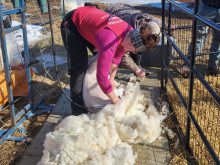HIGH RIVER, Alta. – It takes Ken Hurlburt awhile to walk through the Highwood auction mart because almost everyone there on sale day knows him and wants to share a joke, offer a handshake or stop for a chat.
Auctioneer John Korry of Colorado, who is in town for an international livestock auctioneer’s competition, stops by as Hurlburt is having lunch. There’s a friendly slap on the back and Korry tells everyone within earshot, “if he ever comes to Colorado, we’ll keep him.”
With partners Bob Dyck, Harvey Bourassa and son Brant, Hurlburt owns the Fort Macleod-Highwood Auction at High River, as well as Fort Macleod Auction. Located in the foothills, the two markets draw thousands of cattle every year from British Columbia and Alberta destined for Alberta feedlots or packing plants.
Read Also

Charges laid after cattle theft
Saskatchewan RCMP lay two charges against a man after six cattle went missing.
After 44 years in the business, Hurlburt is a flesh-and-blood reminder of traditional cattle auctions – a business that has seen its power steadily wane in recent years.
Today, Hurlburt turns a lot of the selling over to his son Brant, saying he no longer has the stamina to sell all day. They sell up to 2,000 head a day at one yard.
“They let me sell for about an hour and a half,” he jokes. “I used to go from early morning to late at night and never stop.”
Over the years, his wife of 48 years and best friend, ReNŽe worked alongside him at the Fort Macleod market until new technology came along.
“I quit when they got computers,” she said. “All the kids worked at the market. They all had to take their turns painting fences or working in the yard.”
Family interest
Today, Brant and daughter Kim Tillsley are the only Hurlburt children who remain directly involved in the family business – a business that has changed dramatically since Hurlburt’s younger days.
Hurlburt recalls cattle used to be sold to buyers in the countryside. No one could learn what prices were being offered, so ranchers introduced price discovery through the auction system. For Hurlburt, an auction is one of the best examples of free enterprise.
However, as more packing plants today offer contracts directly to producers, price information could be silenced again, he said.
“As the packing plants get bigger, they’d rather work on a one-on-one basis than they would deal in an open market where you have many buyers,” said Hurlburt.
“It’s big business today and if the industry is going to flourish we have to have competition.”
As well, the types of cattle are different than the animals Hurlburt sold in his younger days. When what were then called exotic cattle, such as Charolais and Simmental, came from Europe in the late 1960s and early ’70s, people couldn’t sell the large-framed white and buckskin calves.
“People laughed at them,” Hurlburt said.
The producers had to finish the calves themselves and sell them as prepared carcasses because no one would buy them alive. It was disheartening.
“When the packers found out (exotic cattle producers) were doing a good job they found the animals were worth a little premium,” he said.
He sees that as a good change in the national herd that ultimately paid off for those who took the risk.
Another evolution taking hold is the sprawling cattle-feeding realm in southern Alberta.
These outfits often hold more than 25,000 head at a time and they need cattle year round. That has caused shifts in calving periods in order to fill pens every month of the year, said Hurlburt.
That in turn has changed the fall cattle feeder runs, which have traditionally pumped thousands of calves onto the market every October and November.
One of the few constants in the business is the auctioneer’s chant, which Hurlburt learned in 1953. That tongue-twisting patter has become synonymous with the North American West as a sales pitch with rapid-fire bids and prices rolling off the auctioneer’s tongue.
Hurlburt, who was born in Lethbridge in 1928, became an auctioneer out of financial desperation.
Disease changes career
Bankruptcy loomed when hoof-and-mouth disease struck his cattle in 1952 on the family ranch they still own near Fort Macleod.
He was losing the bank’s money, so with a $500 gift from a business partner, he went to auction school in Billings, Montana. It wasn’t the career path he intended to travel.
“I had to do it and the more I got into it, I loved it,” he said.
Hurlburt was elected to Parliament in 1972 for the Lethbridge-Foothills constituency and participated in other changes for agriculture. Sitting on the opposition bench as a Progressive Conservative, he faced off against Eugene Whelan, Liberal agriculture minister at the time.
“We got along fine. He was a pretty nice guy except he favored marketing boards for all commodities,” said Hurlburt, who prefers free enterprise and open markets.
One area where he is proud to have made change came in legislation for the humane treatment of horses destined for slaughter in Europe. Many of them were subjected to poor conditions and died in transit. Now horses are killed in Canada rather than shipped overseas.
“I don’t get any credit for it but that’s not really important,” he said.

















